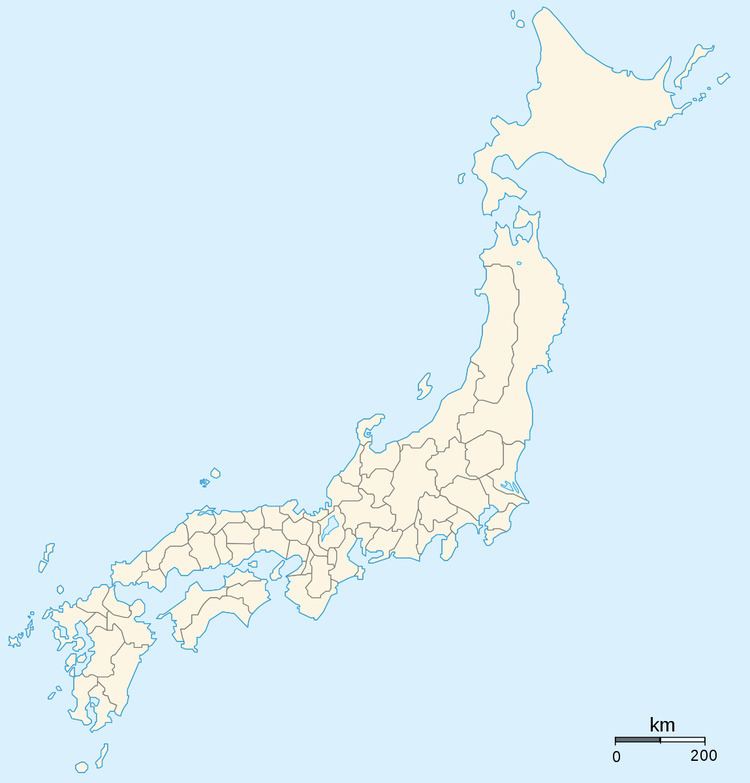 | ||
The Fuhanken Sanchisei (府藩県三治制, "Fu, Han and Ken Tripartite Governance System") was an administrative reorganization undertaken by the Meiji Government in 1868, during the fall of the Tokugawa shogunate and the Boshin War. Over a period of four years, the old Provinces of Japan were recategorised into three different jurisdictions: urban prefectures (府, fu), Daimyo Domains (藩, han) and rural prefectures (県, ken). This, along with further reforms during the abolition of the han System in 1871, led to the shaping of 45 of the 47 modern-day Prefectures of Japan.
Contents
- Background
- History
- Establishment of urban prefectures
- Naming and jurisdiction
- Established prefectures
- Hokkaido and Thoku
- References
Of the current prefectures existing in Japan, several of these were established in approximately their current forms during this era: Nagasaki Prefecture, Osaka Prefecture, Nara Prefecture, Shiga Prefecture (as Ōtsu-ken) and mainland Niigata Prefecture (without the addition of Sado Island in 1876).
Background
At the end of the Asuka period, the Kokugunri system (国郡里制, Kokugunri-sei) and the Taihō Code were enacted in 701 and 702. These pieces of legislation split the regions of Japan into different areas, using terminology of the Tang dynasty due to Confucian influences in Japan. This led to the creation of Provinces (国, kuni), which were split into Districts (郡, gun, kōri). Other than the area surrounding the capital Nara (Kinai), Japan was organised into large regions called circuits (道, dō).
During the Tokugawa shogunate, lands were controlled by individual clans led by a Daimyo, called a han. Each han was a separate state with its own laws. In 1866, the Satsuma Domain and Chōshū Domain formed the Satchō Alliance in order to overthrow the Tokugawa Shogunate and strengthen the powers of the Emperor. This was successful, leading to the start of the Boshin War and the Meiji Restoration. The Tokugawa capital of Edo fell in May 1868, leading to the Meiji government taking charge of the country.
History
In June 1868, an interim constitution called the Seitaisho (政体書) was proclaimed, drafted by Fukuoka Takachika and Soejima Taneomi, which established central government in Japan under the Meiji government. The act dissolved the Tokugawa era court houses, creating government controlled prefectural governors called chifuji (知府事) and chikenji (知県事). All other areas still under the power of a daimyo, han, were left as they were with no structure changes, and an independent justice system.
On June 14, 1868, Hakodate-fu and Kyoto-fu were established as the first two prefectures under the new changes. At the time, the Imperial government army forces were fighting the Republic of Ezo in the Battle of Hakodate, and despite the proclamation, the city of Hakodate had not fallen yet. By end of June, 11 prefectures had been created, including Edo-fu.
In July and August 1869 during the abolition of the han system, the government issued hanseki hokan (版籍奉還) to the remaining Han, asking them to voluntarily return their domains, and later were ordered to by the Court, on threat of military action. The Daimyo who agreed to this were appointed as chihanji (知藩事, "domain governors"), who had to follow the laws and instructions of the central government.
Many territories that became the first prefectures were territories confiscated from domains in the Boshin War, especially domains part of the Ōuetsu Reppan Dōmei alliance.
Areas in Kanto did not initially receive a proper prefecture name and suffix, even though they had appointed officials for the areas.
Establishment of urban prefectures
When initially creating prefecture suffixes, the Seitaisho proclaimed all areas with a jōdai (castle minder), namely Osaka, Sunpu and Kyoto, the shoshidai or a bugyō were given the prefectural suffix fu, while any other area was designated ken. The first two urban prefectures (府, fu) were created on June 14, 1868: Kyoto-fu and Hakodate-fu. By the end of 1868, ten fu had been established: Kyoto, Hakodate, Osaka, Nagasaki, Edo (later Tokyo), Kanagawa, Watarai, Nara, Echigo (later Niigata) and Kōfu. Due to some prefectures gaining non-urban land or being amalgamated into other territories, in 1869 three remained: Kyoto-fu, Osaka-fu and Tokyo-fu. This remained the same until 1943, when Tokyo-fu and Tokyo-shi were merged to form Tokyo-to.
Naming and jurisdiction
It was the convention to name prefectures and han after the location of their prefectural offices. However, this sometimes led to confusing names, with offices located non-centrally, or in exclaves. For example, Nirayama-ken was named after Nirayama on the Izu Peninsula, but administered parts of Shizuoka, Yamanashi, Tokyo, Kanagawa and Saitama. Many prefectures were merged for administration efficiency, but in October and November 1871 during the abolition of the han most of these were reorganised into a completely different form.
Established prefectures
The prefectures listed below were all established before the abolition of the han system. Disestablishment is only listed if prior to August 29, 1871, the time abolition came into effect.
Hokkaido and Tōhoku
After the Daimyo of the northern domains were stripped of their social status in the Boshin War, the following Prefectures were created. These were mostly in name only, and did not function as proper entities.
